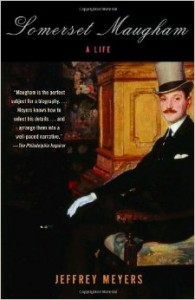 Somerset Maugham: A Life
Somerset Maugham: A Life
by Jeffrey Meyers
Knopf. 432 pages, $30.
One thing that comes through clearly in this new biography by Jeffrey Meyers is that W. Somerset Maugham was not an easy man to know. A multi-talented workaholic who avoided speaking at length due to a lifelong stammer, he poured a great deal of emotional energy into his career and had little left over for other human beings.
Maugham was born in France in 1874 to British parents who were affectionate and reasonable by Victorian standards, albeit often absent. The death of his mother at age eight and of his father two years later was undoubtedly a factor in his lifelong fear of intimacy. From his parents’ lively home in Paris he was sent to live with a dour, repressed clergyman uncle and his equally rigid wife in Whitstable, England. He later went back to the Continent to study in Heidelberg, Germany (in a living situation easily recognizable in Of Human Bondage), and finally returned to England to obtain a medical degree at St. Thomas (where he apparently took every opportunity to practice giving enemas to his fellow students). His special interest was obstetrics, doubtless a tribute to his mother, who died shortly after giving birth (the infant also died). Though he appears to have been a competent physician, he gave up medicine early on to become a writer.
Maugham described himself as “three quarters queer and one quarter not,” yet he tried to uphold traditional Victorian–Edwardian values by suppressing his homosexual nature and seeking to marry. For a man so focused and resolute, such an enormous denial of his true self made him cautious and calculating. This was only one aspect of the duality of his nature. Another was his half-French, half-British cultural identity. Yet another was the way in which he straddled the Victorian era and the post-World War I era, living through ninety years of dramatic change in human civilization.
Meyers faithfully records Maugham’s activities in the Great War as an intelligence agent for the British government. He spent time in Russia, where his mission was to help keep the Bolsheviks at bay. Meyers uses this occasion to drop so many names and go on so many tangents regarding the Russian Revolution that the subject of the book is almost lost for a time.
Maugham had two significant love affairs with other men, the first with Gerald Haxton and the second with his longtime lover, Alan Searle. Meyers chooses to treat these relationships rather superficially, dwelling instead on his connections with the actress Sue Jones, whom Maugham came close to marrying. And yet, by his own admission marriage was for Maugham little more than a ticket to literary and social respectability. Although he bought into the belief that his homosexuality condemned him to a second-rate life, he cannot be dismissed as merely a closeted writer. Whatever his caution in his personal life, he used his fiction to convey an understanding of men far less inhibited than himself.





